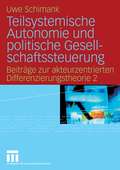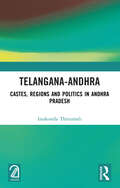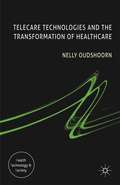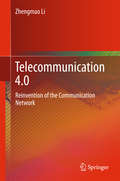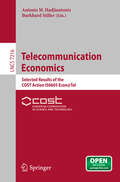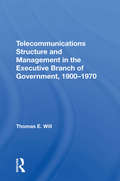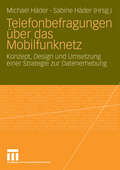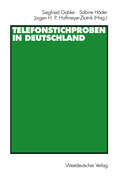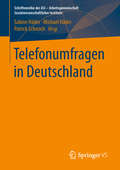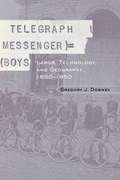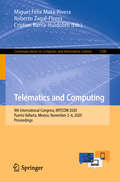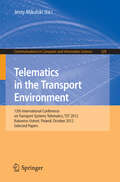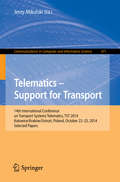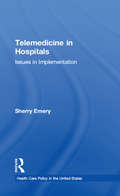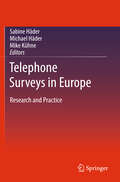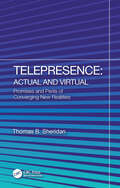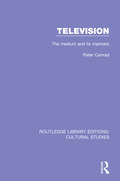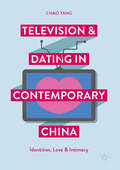- Table View
- List View
Teilsystemische Autonomie und politische Gesellschaftssteuerung: Beiträge zur akteurzentrierten Differenzierungstheorie 2
by Uwe SchimankDie Autonomie der Teilsysteme der funktional differenzierten modernen Gesellschaft kann immer wieder in doppelter Hinsicht prekär werden. Teilsystemische Autonomie kann durch Einwirkungen anderer Teilsysteme gefährdet werden; und sie kann zur Verselbständigung gegenüber gesellschaftlichen Integrationserfordernissen ausarten. Politische Gesellschaftssteuerung ist einer der Mechanismen, die in der modernen Gesellschaft eine ausbalancierte Autonomie der Teilsysteme und damit funktionale Differenzierung sichern sollen. Diese Zusammenhänge von gefährdeter und gefährdender teilsystemischer Autonomie auf der einen, auf beides reagierender politischer Gesellschaftssteuerung auf der anderen Seite sind Thema der Beiträge dieses Bandes.
Telangana-Andhra: Castes, Regions and Politics in Andhra Pradesh
by Inukonda ThirumaliThis book is an attempt to present the inside story of the Telangana movement that developed due to historical reasons. The movement, in this work, has brought forward the Telangana lower class’s response to the established cultural hegemony of the Andhra linguistic elite and affluent agrarian communities who, in their perception, monopolized the political power and economic resources. The movement voices the democratic yearnings of service castes, artisans, Dalits and nomads who through their instant association with the movement expressed aspirations for their due share in political power and administrative structure. The leadership that has come from the regional elite has, however, articulated only the reasons of 'self-respect and regional autonomy'. This work brings out the two-fold character in the movement. It also gives insights into the possible need of remaking states in India in the interest of the inclusion of these social groups in political structures so that democracy might further percolate downwards. This book is co-published with Aakar Books. Print edition not for sale in South Asia (India, Sri Lanka, Nepal, Bangladesh, Pakistan and Bhutan)
Telangana-Andhra: Castes, Regions and Politics in Andhra Pradesh
by Inukonda ThirumaliThis book is an attempt to present the inside story of the Telangana movement that developed due to historical reasons. The movement, in this work, has brought forward the Telangana lower class’s response to the established cultural hegemony of the Andhra linguistic elite and affluent agrarian communities who, in their perception, monopolized the political power and economic resources. The movement voices the democratic yearnings of service castes, artisans, Dalits and nomads who through their instant association with the movement expressed aspirations for their due share in political power and administrative structure. The leadership that has come from the regional elite has, however, articulated only the reasons of 'self-respect and regional autonomy'. This work brings out the two-fold character in the movement. It also gives insights into the possible need of remaking states in India in the interest of the inclusion of these social groups in political structures so that democracy might further percolate downwards. This book is co-published with Aakar Books. Print edition not for sale in South Asia (India, Sri Lanka, Nepal, Bangladesh, Pakistan and Bhutan)
Telecare Technologies and the Transformation of Healthcare (Health, Technology and Society)
by N. OudshoornWinner of the British Sociological Association Foundation for the Sociology of Health and Illness Book Prize, 2012. This book traces the changes in healthcare implicated in telecare technologies: information and communication technologies that enable care at a distance. What happens when healthcare moves from physical to virtual encounters between healthcare professionals and patients? What are the consequences for patients when they are expected to do things that used to be done by healthcare professionals? What actually happens when homes become electronically wired to healthcare organizations? These are urgent questions that are, however, largely absent in dominant discourses on telecare. Drawing on insights from science, technology, and human geography, this work opens up novel accounts of the adoption and use of new technologies in healthcare. Nelly Oudshoorn shows how telecare technologies participate in redefining the responsibilities and identities of patients and healthcare professionals, introducing a new category of healthcare workers, and changing the kinds of care and spaces where healthcare is situated. This book intervenes critically into discourses that celebrate the independence of place and time by showing how places and physical contacts still matter in care at a distance.
Telecommunication 4.0: Reinvention of the Communication Network
by Zhengmao LiThis book proposes for the first time the concept of communication 4.0, exploring its nature in detail, and offering predictions for the future development of the telecommunication industry. Based on an in-depth analysis of hierarchical communications requirements, it applies Maslow’s Model to telecommunication and illustrates the model’s five degrees.
Telecommunication Economics: Selected Results of the COST Action IS0605 Econ@Tel (Lecture Notes in Computer Science #7216)
by Antonis M. Hadjiantonis Burkhard StillerThis book constitutes a collaborative and selected documentation of the scientific outcome of the European COST Action IS0605 Econ@Tel "A Telecommunications Economics COST Network" which run from October 2007 to October 2011. Involving experts from around 20 European countries, the goal of Econ@Tel was to develop a strategic research and training network among key people and organizations in order to enhance Europe's competence in the field of telecommunications economics. Reflecting the organization of the COST Action IS0605 Econ@Tel in working groups the following four major research areas are addressed: - evolution and regulation of communication ecosystems; - social and policy implications of communication technologies; - economics and governance of future networks; - future networks management architectures and mechanisms.
Telecommunications Structure and Management in the Executive Branch of Government 1900-1970
by Thomas E. WillIn early 1970 President Richard M. Nixon created a new executive office, the Office of Telecommunications Policy (OTP), and appointed Dr. Clay T. Whitehead as OTP's first director. (Whitehead had previously been on the staff of Peter Flanigan, a presidential assistant responsible for telecommunications policy at the White House.) What was the motivation behind this action? Were political interests being served? With what results? Thomas Will believes that these and other questions must be raised in view of the history of the Nixon administration. In an attempt to answer them, he examines the development of telecommunications policy in the executive branch from 1900 to 1970. Dr. Will reviews the early executive branch involvement in radio telecommunications, the Radio Act of 1927 and the Communications Act of 1934, the technological advance of radio telecommunications and its effect on the executive branch before and after World War II, the. appointments of telecommunications advisors to presidents from 1951 to 1967, and the creation of the President's Task Force in 1967 to deal with the problems created by an inherently limited radio spectrum. He traces the steps taken to create the OTP and analyzes the extent to which the office reflected a traditional progression of executive branch telecommunications authority. His study and conclusions are directly and essentially relevant to the current debate on telecommunications policy.
Telecommunications Structure and Management in the Executive Branch of Government 1900-1970
by Thomas E. WillIn early 1970 President Richard M. Nixon created a new executive office, the Office of Telecommunications Policy (OTP), and appointed Dr. Clay T. Whitehead as OTP's first director. (Whitehead had previously been on the staff of Peter Flanigan, a presidential assistant responsible for telecommunications policy at the White House.) What was the motivation behind this action? Were political interests being served? With what results? Thomas Will believes that these and other questions must be raised in view of the history of the Nixon administration. In an attempt to answer them, he examines the development of telecommunications policy in the executive branch from 1900 to 1970. Dr. Will reviews the early executive branch involvement in radio telecommunications, the Radio Act of 1927 and the Communications Act of 1934, the technological advance of radio telecommunications and its effect on the executive branch before and after World War II, the. appointments of telecommunications advisors to presidents from 1951 to 1967, and the creation of the President's Task Force in 1967 to deal with the problems created by an inherently limited radio spectrum. He traces the steps taken to create the OTP and analyzes the extent to which the office reflected a traditional progression of executive branch telecommunications authority. His study and conclusions are directly and essentially relevant to the current debate on telecommunications policy.
Telefonbefragungen über das Mobilfunknetz: Konzept, Design und Umsetzung einer Strategie zur Datenerhebung
by Michael Häder Sabine HäderDas Buch stellt eine neue Form der Datenerhebung vor: Die Telefonbefragung über das Mobilfunknetz. Diese Methode wird aufgrund der zunehmenden Verbreitung von Handys und dem gleichzeitigen Verzicht auf Festnetzanschlüsse immer relevanter. Dies ist das erste Buch, das die Methode und deren Umsetzung darstellt. Es ist im Ergebnis eines von der Deutschen Forschungsgemeinschaft geförderten Projekts entstanden, das sich der Integration von Mobilfunkanschlüssen in Telefonstichproben und der Befragung in beiden Netzen widmet. Bei dem Projekt handelt es sich um eine Kooperation zwischen der Technischen Universität Dresden und GESIS - Leibniz-Institut für Sozialwissenschaften. Neben der Entwicklung eines Stichprobendesigns wurden in der Befragung (jeweils 1.000 Interviews über Festnetz und Mobilfunk) vor allem mögliche Mode-Effekte näher untersucht sowie die prinzipielle Bereitschaft zu Umfragen in der Allgemeinbevölkerung über den Mobilfunk ergründet.
Telefonstichproben in Deutschland
by Siegfried Gabler Sabine Häder Jürgen H. P. Hoffmeyer-ZlotnikIn der deutschen Sozial- und Marktforschung haben Telefoninterviews gegenwärtig einen Anteil von ca. 40 Prozent. Insofern sind Designs von Stichproben für Bevölkerungsbefragungen von großem Interesse. Aufgrund verschiedener Veränderungen auf dem deutschen Telekommunikationsmarkt reicht das Telefonbuch als adäquater Auswahlrahmen für die Stichprobenziehung nicht mehr aus. Deshalb werden die aus den USA bekannten Methoden wie Randomize Last Digit und Random Digit Dialing zunehmend diskutiert und eingesetzt. Diese Methoden werfen bei der komplizierten Rufnummernstruktur in Deutschland allerdings Probleme auf. Dieser Sammelband behandelt die genannten Fragestellungen und zeigt neue Wege auf. Die Beiträge zu organisatorischen, technischen bis wahrscheinlichkeitstheoretischen Fragen, die Darstellung von Datenschutzproblemen sowie die Erfahrungsberichte und Überlegungen zur bisherigen und zukünftigen Entwicklung auf dem deutschen Telekommunikationsmarkt vermitteln ein sehr facettenreiches Bild und bieten den Forschern und Anwendern in den Umfrageinstituten eine Hilfe für die praktische Arbeit auf dem Gebiet der Telefonstichprobe.
Telefonumfragen in Deutschland (Schriftenreihe der ASI - Arbeitsgemeinschaft Sozialwissenschaftlicher Institute)
by Sabine Häder Michael Häder Patrick SchmichDas vorliegende Buch gibt einen Überblick über den aktuellen Stand der Forschung im Bereich telefonischer Befragungen. Ziel der Autoren war es, sowohl wissenschaftlich Forschenden eine kompakte Übersicht zu geben, als auch Institutionen, die über telefonische Befragungen nachdenken, konkrete Hinweise für die Umsetzung zu geben. Es sollen Good Practice Guidelines im Sinne von bewährten Verfahren und auf praktischen Erfahrungen beruhende Empfehlungen vermittelt werden. Den Lesern wird eine Hilfestellung geboten, um sich über die erforderlichen Schritte, angefangen bei der Ausschreibung einer Studie, über die relevanten Aspekte der Fragebogenerstellung und zum Verständnis der Auswahlstrategie bis hin zum Inhalt der Methodenberichte, zu informieren. Die Klammer des Buches ist die Einordnung der verschiedenen Phasen von Telefonumfragen in das Ziel der Verringerung des Total Survey Error (TSE).Der InhaltDas Total Survey Error Modell in telefonischen Befragungen ● Repräsentativität: Versuch einer Begriffsbestimmung ● Telefonstichproben ● Erhebung und Verwendung von Para- und Metadaten ● Fragebogenkonstruktion bei telefonischen Befragungen ● Feldphase ● Rolle und Einfluss von Interviewern in telefonischen Umfragen ● Datenqualität ● Die Berechnung von Responseraten ● Gewichtung von (Dual-Frame -) Telefonstichproben ● Methoden- und Feldberichte ● Ausschreibung einer TelefonstudieDie HerausgeberProf. Dr. Michael Häder ist Inhaber der Professur für Methoden der empirischen Sozialforschung an der TU Dresden.Dr. Sabine Häder ist Mitarbeiterin am GESIS − Leibniz-Institut für Sozialwissenschaften in Mannheim.Patrick Schmich ist Leiter des Fachgebietes Epidemiologisches Daten- und Befragungszentrum am Robert Koch-Institut Berlin.
Telegraph Messenger Boys: Labor, Communication and Technology, 1850-1950
by Gregory J. DowneyIn Telegraph Messenger Boys Gregory J. Downey provides an entirely new perspective on the telegraph system: a communications network that revolutionized human perceptions of time and space. The book goes beyond the advent of the telegraphy and tells a broader story of human interaction with technology and the social and cultural changes it brought about.
Telegraph Messenger Boys: Labor, Communication and Technology, 1850-1950
by Gregory J. DowneyIn Telegraph Messenger Boys Gregory J. Downey provides an entirely new perspective on the telegraph system: a communications network that revolutionized human perceptions of time and space. The book goes beyond the advent of the telegraphy and tells a broader story of human interaction with technology and the social and cultural changes it brought about.
Telematics and Computing: 9th International Congress, WITCOM 2020, Puerto Vallarta, Mexico, November 2–6, 2020, Proceedings (Communications in Computer and Information Science #1280)
by Miguel Félix Mata-Rivera Roberto Zagal-Flores Cristian Barria-HuidobroThis book constitutes the thoroughly refereed proceedings of the 9th International Congress on Telematics and Computing, WITCOM 2020, held in Puerto Vallarta, Mexico, in November 2020. Due to the COVID-19 pandemic the conference was held online. The 28 full papers and 3 short papers in this volume were carefully reviewed and selected from 79 submissions. The papers are focused on the topics of deep and machine learning, cybersecurity, wireless networks, computer vision, communications, and education applied to different sceneries of study and COVID-19.
Telematics in the Transport Environment: 12th International Conference on Transport Systems Telematics, TST 2012, Katowice-Ustron, Poland, October 10--13, 2012, Selected Papers (Communications in Computer and Information Science #329)
by Jerzy MikulskiThis book constitutes the proceedings of the 12th International Conference on Transport Systems Telematics, TST 2012, held in Katowice-Ustron, Poland, in October 2012. The 48 papers included in this volume were carefully reviewed and selected for inclusion in this book. Transport telematics are the systems using the information and communication technologies in the area of infrastructure and of means of transport and its participants. An intelligent transport covers systems that allow, through the data transmission and analysis, to influence the behaviour of road users and the action of technical elements in means of transport or along the traffic route. Intelligent transport systems - in accordance with the European Directive - are used for the transport management informatisation. The research shows that the use of telematics can significantly increase the efficiency of the transport system, the road safety and the environmental protection. This book provides an overview of solutions being developed in the field of intelligent transportation systems, and includes theoretical and case studies in the countries of conference participants.
Telematics - Support for Transport: 14th International Conference on Transport Systems Telematics, TST 2014, Katowice/Krakow/Ustron, Poland, October 22-25, 2014. Proceedings (Communications in Computer and Information Science #471)
by Jerzy MikulskiThis book constitutes the proceedings of the 14th International Conference on Transport Systems Telematics, TST 2014, held in Katowice/Kraków and Ustroń, Poland, in October 2014. The 49 papers included in this volume were carefully reviewed and selected from 125 submissions. The papers provide an overview of solutions being developed in the fields of transport telematics and intelligent transport systems.
Telemedicine in Hospitals: Issues in Implementation (Health Care Policy in the United States)
by Sherry EmeryThis book looks at the history and development of telemedicine and its effect on the medical profession. It includes advances in telecommunications and medical technologies that greatly have increased the reliability, resolution, and speed of transmitting medical images, changes that are have been affected by changes in the national and global economies and the support to rural hospitals during the 1990s.
Telemedicine in Hospitals: Issues in Implementation (Health Care Policy in the United States)
by Sherry EmeryThis book looks at the history and development of telemedicine and its effect on the medical profession. It includes advances in telecommunications and medical technologies that greatly have increased the reliability, resolution, and speed of transmitting medical images, changes that are have been affected by changes in the national and global economies and the support to rural hospitals during the 1990s.
Telephone Surveys in Europe: Research and Practice
by Sabine Häder Michael Häder Mike KühneThe first part of this book deals with the coverage of landline and mobile phones in Europe. It presents an overview of the coverage and the use of phones as well as the resulting strategies for telephone surveys. The second part addresses the challenge of so-called “mobile‐only” households for survey research. Numerous statisticians present new sampling strategies like dual frame designs and findings of current projects. In dual frame designs, respondents are contacted both via mobile phone and landline. The third part focuses on the usage of mobile phones in the general population, while the fourth part of examines if different modes of data collection (mobile vs. landline) have an impact on the response quality. The last part analyses the first chapter and offers suggestions and advice on how to conduct surveys and polls, in both academic and market research.
Telepresence: Promises and Perils of Converging New Realities
by Thomas B. SheridanTelepresence: Actual and Virtual explores the history of telepresence from the 1948 developments of master–slave manipulation, through to current telepresence technology used in space, undersea, surgery and telemedicine, operations in nuclear and other hazardous environments, policing and surveillance, agriculture, construction, mining, warehousing, education, amusement, social media, and other contexts. It also describes the various operator hand and body controls and the corresponding telerobotic actuation of robotic hands, arms, and locomotion. This book reviews the sensing and control technology, its history and likely future, and discusses the many research and policy issues that are raised. The book also takes up key questions relating to social and ethical issues, given that a person’s mechanical reach is becoming unlimited, enabling one to perform mischievous or harmful acts without identification, and what that portends for future developments in telepresence, including regulation and recommended directions of development. The primary audience for this book is professionals interested in human–robot interaction, human factors engineering, virtual reality, applications to space and undersea exploration, telemedicine and telesurgery, firefighting, mechanized agriculture, policing, drone surveillance, warehouse parts' fetching, mining, and military operations.
Telepresence: Promises and Perils of Converging New Realities
by Thomas B. SheridanTelepresence: Actual and Virtual explores the history of telepresence from the 1948 developments of master–slave manipulation, through to current telepresence technology used in space, undersea, surgery and telemedicine, operations in nuclear and other hazardous environments, policing and surveillance, agriculture, construction, mining, warehousing, education, amusement, social media, and other contexts. It also describes the various operator hand and body controls and the corresponding telerobotic actuation of robotic hands, arms, and locomotion. This book reviews the sensing and control technology, its history and likely future, and discusses the many research and policy issues that are raised. The book also takes up key questions relating to social and ethical issues, given that a person’s mechanical reach is becoming unlimited, enabling one to perform mischievous or harmful acts without identification, and what that portends for future developments in telepresence, including regulation and recommended directions of development. The primary audience for this book is professionals interested in human–robot interaction, human factors engineering, virtual reality, applications to space and undersea exploration, telemedicine and telesurgery, firefighting, mechanized agriculture, policing, drone surveillance, warehouse parts' fetching, mining, and military operations.
Television: The Medium and its Manners (Routledge Library Editions: Cultural Studies)
by Peter ConradIt dominates our lives. It is the twentieth-century medium. And yet we're all a little sheepish when it comes to television, disowning it by disavowal or by inventing subtle, innocuous disguises for it. Why is this? In this book, first published in 1982, Peter Conrad argues that our unease stems from the way that the medium works: it absorbs the messages it transmits, it invents a reality of its own and ends by luring the world into the confines of its box. Television's achievement is to have estranged us from the reality which it puports to represent, but which it actually refracts. This invasion of our lives is monitored and projected in programmes designed to ape the human routine. Following a discussion of television as furniture, Peter Conrad explores its various versions of reality: the simulated conversation of the talk show, the competitive consumerism of the games, the messianic commercials, the eventless protraction of the soap operas and the camera's incitement of happenings which the television calls news.
Television: The Medium and its Manners (Routledge Library Editions: Cultural Studies)
by Peter ConradIt dominates our lives. It is the twentieth-century medium. And yet we're all a little sheepish when it comes to television, disowning it by disavowal or by inventing subtle, innocuous disguises for it. Why is this? In this book, first published in 1982, Peter Conrad argues that our unease stems from the way that the medium works: it absorbs the messages it transmits, it invents a reality of its own and ends by luring the world into the confines of its box. Television's achievement is to have estranged us from the reality which it puports to represent, but which it actually refracts. This invasion of our lives is monitored and projected in programmes designed to ape the human routine. Following a discussion of television as furniture, Peter Conrad explores its various versions of reality: the simulated conversation of the talk show, the competitive consumerism of the games, the messianic commercials, the eventless protraction of the soap operas and the camera's incitement of happenings which the television calls news.
Television and Dating in Contemporary China: Identities, Love and Intimacy
by Chao YangThis book considers the changing nature of intimacy in contemporary China, providing a unique case study of romantic subjectivities in young people in the world’s fastest growing economy. Since the implementation of reform in 1978, the economic and socio-cultural environment of modern China has experienced a dramatic transformation under the influence of urbanization and globalization, facilitating more individualized identity among Chinese youth. This book bridges the gap between an emergent emphasis on individualisation and the country’s traditional norms and values. It focuses on young people’s understandings of various forms of relationships such as cohabitation, extramarital relationships and multiple relationships, suggesting a challenge to traditional familial values and an increasingly diversified understanding of the concepts of love and romance. By examining the formation of relationships among 21st century Chinese youth, notably through the lens of popular Chinese TV dating programs, this book considers how dating and relationships mirror China’s changing societal structure and examines social and cultural transformations in Chinese society.
Television and Dating in Contemporary China: Identities, Love and Intimacy
by Chao YangThis book considers the changing nature of intimacy in contemporary China, providing a unique case study of romantic subjectivities in young people in the world’s fastest growing economy. Since the implementation of reform in 1978, the economic and socio-cultural environment of modern China has experienced a dramatic transformation under the influence of urbanization and globalization, facilitating more individualized identity among Chinese youth. This book bridges the gap between an emergent emphasis on individualisation and the country’s traditional norms and values. It focuses on young people’s understandings of various forms of relationships such as cohabitation, extramarital relationships and multiple relationships, suggesting a challenge to traditional familial values and an increasingly diversified understanding of the concepts of love and romance. By examining the formation of relationships among 21st century Chinese youth, notably through the lens of popular Chinese TV dating programs, this book considers how dating and relationships mirror China’s changing societal structure and examines social and cultural transformations in Chinese society.
